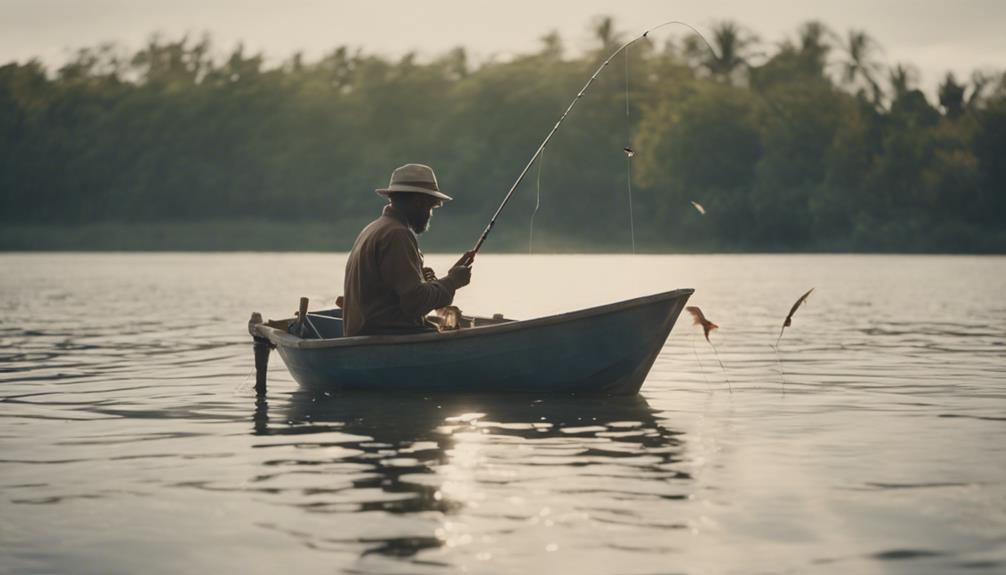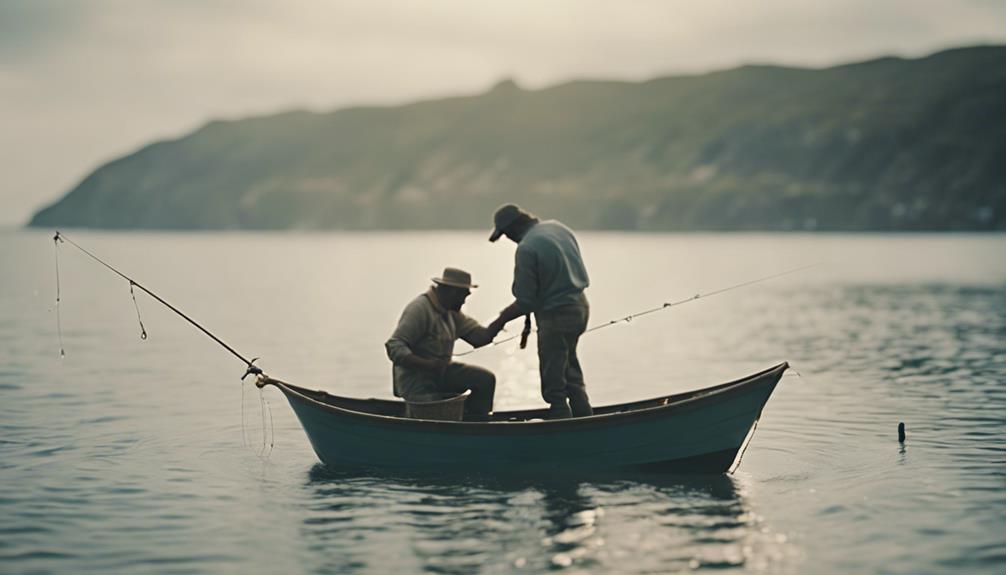Have you ever wondered if there is a way to fish that not only upholds the environment but also guarantees the well-being of the fish population?
Ethical hand line fishing techniques offer a solution to this dilemma, providing a sustainable approach to angling that minimizes harm to marine life. By understanding and implementing these techniques, you can make a positive impact on the ecosystem while enjoying the thrill of fishing.
But how exactly can you achieve this balance between recreation and conservation? Let's explore the principles and practices of ethical hand line fishing to uncover the secrets behind this environmentally conscious approach.
Key Takeaways
- Use single fishing lines with barbless hooks for minimal harm.
- Fish in specific water layers to target desired species.
- Emphasize proper catch and release techniques for fish survival.
- Promote sustainable practices to conserve marine resources.
Importance of Ethical Hand Line Fishing

Ethical hand line fishing is crucial for preserving marine ecosystems and minimizing harm to unintended fish species. By practicing ethical fishing techniques, you guarantee the conservation of marine resources. This approach reduces the unintentional death of non-targeted fish, showing respect for fisheries, the natural environment, and fellow anglers.
Each angler's commitment to ethical fishing can have a significant impact on conservation efforts, especially considering the millions of fishing trips taken annually. Responsible hand line fishing guarantees that future generations can also enjoy the abundance of marine life.
Improving ethical fishing practices can lead to hundreds of thousands of fish remaining in the environment, making a tangible difference in the sustainability of marine ecosystems.
Principles of Ethical Hand Line Fishing

When practicing hand line fishing, prioritize minimizing harm to unintended fish species by employing specific techniques. Using a selective method can help target only the desired fish, reducing the impact on other species.
It's important to handle caught fish carefully, ensuring they remain in good condition if released. Live fish should be promptly returned to the water to increase their chances of survival.
Conservation efforts play a significant role in ethical hand line fishing, with recreational anglers taking responsibility for the well-being of fish populations. By following these principles, anglers can contribute to the sustainability of fisheries and the environment, promoting a harmonious relationship between recreational fishing and conservation efforts.
Techniques for Ethical Hand Line Fishing

What key techniques can enhance the ethical practice of hand line fishing?
Hand line fishing is a small-scale fishing method that involves using a single fishing line with a lure or bait attached. To secure ethical practices, consider fishing in specific water layers where target species are found, reducing the likelihood of unintentionally catching non-targeted fish.
By using barbless hooks and promptly releasing any unwanted catches, you can minimize harm to fish populations. Additionally, practicing proper catch and release techniques, such as handling fish with wet hands and minimizing air exposure, can increase their chances of survival.
These techniques promote sustainable fishing practices and contribute to the conservation of marine resources for future generations.
Benefits of Ethical Hand Line Fishing

To understand the positive outcomes of ethical hand line fishing, consider how your conscious angling choices contribute to the well-being of marine ecosystems.
Benefits of Ethical Hand Line Fishing:
- Conservation: Ethical fishing helps in conserving marine resources for future generations.
- Respect: Promotes respect for fisheries, the environment, and fellow anglers.
- Reduced Bycatch: Reduces unintentional death of non-targeted fish species.
- Impactful Conservation: Each angler's commitment to ethical fishing can have a significant conservation impact, preserving hundreds of thousands of fish in the environment.
Future of Ethical Hand Line Fishing

The future of ethical hand line fishing entails embracing sustainable practices to safeguard marine ecosystems. By focusing on relatively small inshore waters, using hand-held fishing lines, and fishing throughout the year, anglers can minimize environmental impact.
Advancements in technology offer opportunities to improve the efficiency and sustainability of hand line fishing methods. Collaborative efforts involving fishers, scientists, and policymakers are essential for developing regulations that promote ethical hand line fishing.
Education and awareness campaigns play a critical role in encouraging responsible fishing practices among anglers and communities. Investing in research and innovation will be key to continuously enhancing ethical hand line fishing techniques, ensuring the long-term health of our oceans and marine life.
Conclusion
In summary, ethical hand line fishing techniques are vital for preserving fish populations and the environment. By following principles like reducing unintentional harm and showing respect for fisheries, anglers can make a positive impact on conservation efforts.
Practicing responsible angling not only benefits current fish populations but also guarantees a sustainable future for generations to come. Remember, your actions matter in protecting our natural resources while enjoying the sport of fishing.
👨👩👧👦 Dwight’s a married dad of 4 who loves to cast a line 🎣 into both fresh and salt waters. His heart belongs to his family and the sea. 🌊 #FamilyMan #FishingLife #DadOf4 🐟✨

